As we head into the final hours of 2024 it seems tradition to reflect on the passing year and contemplate goals and actions for the coming year.
As I look back, I see housing related discussions and policy actions are inching forward across northern Illinois. While I cannot say here at home “nothing is happening,” I see other communities making far faster progress and wonder why we are content with far less advancement? Yes, local multi-family rental housing developments are coming forward, but single family and workforce housing are still at what I would classify as stagnant levels, or at least levels far short of the needs we have identified – 3,000 to 10,000 units.
Since I started publishing on Substack (Sept. 2023), I have now written 31 housing related articles. Adding this one to the mix accounts for the 15 written this year. Let’s look back at a few of the 2024 articles that stand out most to me. These are the ones I see as most relevant and worthy of continued consideration here in Rockford.
Below – Italicized text is a direct excerpt from the original piece I reference.
Incentivizing Housing Production - The answer is DENSITY (January 7, 2024). I have long heard Rockfordians tout that density is bad and often one will hear elected officials cite the dangers of density. These alleged dangers include higher crime, unhealthy conditions, and a host of other unsupported claims; however, given that these decision makers control what land use policies get adopted, we have embraced sprawl, increased minimum lot sizes, and [historically] focused primarily on single family housing production. I would say not much has been done to truly address our land use regulations, return to smaller lots, and incentivize infill low density multifamily or single family units because we have yet to see any real production since 2007.
That said, the City of Rockford did pass an incentive package for those building new housing units to abate property tax for three years and waive water and permit fees. The incentive package has had modest impact in single family production, and in my opinion hasn’t yet hit to the heart of the problem, land use regulations, and other requirements still keep housing returns (aka profit) at high risk levels. With risk levels high, builders are pensive in any approach to speculate on new housing production. And, until local elected truly understand the value of density, like lower cost per unit community services, higher tax collections by utilized acre, and more, our business community, particularly our downtown and downtown adjacent neighborhoods, will never truly reap the benefits of a healthy population with various levels of disposable income that appropriately support retail and restaurants. Retail and restaurants drive sales tax revenue and city fees.
Homelessness – A Systems Problem. A lesson for all from Rockford, Illinois (February 11, 2024). The article focused on Rockford’s once national ranking as the first city in the nation to effectively end veteran’s homelessness – worthy of significant praise; however, our community teams are losing ground to homelessness as housing costs continue to rise and stress resident’s budgets.
In Rockford, the 2021 share of renters spending more than 30% of their income on housing expenses (aka housing burdened) exceeded 52% and the trend of increasing burden continued as rent rose through 2024.
In 2021 the average 2-bedroom rent was approximately $825/mo. In 2024 the average 2-bedroom rent peaked at $1,200/mo. – a 45% increase in three years. And, while rents are now trending downward, they are still higher than the 2021 rate, suggesting that more renters may be rent burdened and the transition to homelessness is likely higher than the norm. It goes without saying, but I’ll say it anyway for those in the back, instability and burden in a rental household can lead to homelessness.
Source: Zumper Rental Market Trends
Source: Harvard Joint Center for Housing Studies tabulations of US Census Bureau, American Community Survey 1-Year Estimates using the Missouri Data Center MABLE/geocorr14
Supporting the idea that higher rents equates to more burdened renters which leads to increased homelessness, the Department of Housing and Urban Development (HUD) just released the 2024 Report to Congress, including the Point in Time Count (PITC). The PITC is the annual count of those homeless in our community. Last year’s PITC was 445 homeless, that rose to 486 this year. This doesn’t mean that there are only 41 more homeless this year vs. last, as over 2024 many where indeed housed.
While the state of Illinois saw 2024 increases larger than our 9% increase, the cumulative growth of homelessness in our community has compounded year over year at a concerning rate – a 41.5% increase in 2022 (over 2021), a 9.6% increase in 2023 (over 2022), and now a 9.2% increase in 2024 (over 2023). We are simply going the wrong way. Of additional concern should be that our under 18 homeless count has been relatively flat for nearly a decade, hovering at about 100 children. We aren’t solving this crisis and lacking housing units won’t help us solve it.
Preventing Lifelong Illnesses, Crime, and Premature Death Through Better Quality Housing - Inspecting homes to improve individual and community outcomes (February 25, 2024). I have to say this is one of my favorite topics – health and housing. For more than a decade I have tried to share the intersectionality of the two and how poor health outcomes are driven by poor neighborhood and housing conditions. Some may say I have preached this, perhaps its true but so long as we continue to allow poor quality rental housing to exist, I will preach on.
The National Center for Health Statistics (NCHS) produces an interactive map to estimate life expectancy at birth. You may use it to check where you live in by clicking on the link and entering your state, county, or your address. We should all be motivated to improve neighborhood and housing conditions when there is a ten-year life expectancy increase for folks living on the east side (Mulford/Spring Creek) over folks living on the west side (Central and West State).
The article also covers lead-based paint problems. In looking at the HUD Highest lead-based paint abatement needs jurisdictions (FY 2020 LHR NOFA), I found Winnebago County was among those jurisdictions listed with the highest abatement (lead removal) needs - 7046 rental units constructed before 1940, 6,074 of them are in the City of Rockford.
…The numbers above suggest that near 450 kids have been identified with toxic levels of lead in their blood, but only 42% of children (0-6) have been evaluated.
What interests me most is that nearly 500 Winnebago County children have been lead “poisoned” and the most common and likely source is the home in which they live and yet locally we have no public “watch list” of homes and their owners who contributed to this condition. A robust watch list serves to protect renters. This is but one condition a robust rental home inspection program can help eliminate – a topic I will address in greater detail in a future post.
Why is lead poisoning a concern? The World Health Organization cites, “Exposure to very high levels of lead can severely damage the brain and central nervous system causing coma, convulsions and even death. Children who survive severe lead poisoning may be left with permanent intellectual disability and behavioral disorders. At lower levels of exposure that may have no obvious symptoms, lead can lead to a spectrum of injury across multiple body systems. Lead can permanently affect children’s brain development, resulting in reduced intelligence quotient (IQ), behavioral changes including reduced attention span and increased antisocial behavior, and reduced educational attainment. Lead exposure also causes anemia, hypertension, renal impairment, immunotoxicity and toxicity to the reproductive organs.”
For the health of our children and families, in 2025, I would love to see a robust rental inspection process evolve and go into effect; however, since we gave up home rule authority, we must go downstate to get this approved. I’d also love to see us take the initiative to go downstate, or preferably, work to reinstate home rule.
Last, my favorite piece I wrote in 2024, The Local Housing Crisis - It’s a leadership problem (October 14, 2024). The following are excerpts from the article and is not a full reprint so the progression of story, like above, may be interrupted, but I believe you will get the intended message.
The article highlights that, In an October 8th, 2024, article in Affordable Housing Finance, An Election in Sight and a Housing System on the Brink, former Department of Housing and Urban Development Secretary, now Enterprise Community Partners CEO and President, Shaun Donovan stated, “…the average cost-burdened household spends $8,000 more [annually] on housing than they can afford, which is nearly the cost of a year’s supply of gas and groceries combined. That, in turn, is putting a drag on our broader economy - even with inflation cooling, housing costs are the driving force for more than 70% of core inflationary gains over the last year.” We should note cost burdened households are about 1/3 of all households and is defined as spending more than 30% of their income on rent or mortgage plus utilities. This one-third includes homeowners at about 20% and renters above 50% as pointed out above.
While we can point to the housing crisis as a national issue, again the control and solutions exists at our local level and some local governments are doing more than others to overcome the challenge. While not all have had the same impact as Minneapolis, many are working to rise to the impact Minneapolis has created and led. NOTE: Minneapolis was the only city in the nation that avoided inflation by building many living units while most of the nation struggled to produce new units.
It’s worth interjecting a recent report from NBC News by Brian Cheung in September, “In the roughly five years since Minneapolis 2040 was approved, rents across the country surged by 22%, according to Apartment List estimates. By contrast, rents in Minneapolis fell by 4% in the same five-year period.” Producing housing not only warded off inflation but helped to create a workforce solution where Minneapolis residents could live close to work.
USA Facts cites, “The rent-to-income ratio in the Minneapolis, Minnesota area is 29.8%, which is below the large metro average of 31.4%. This means that a typical household in the Minneapolis area spends less than 30% of their income on rent and is not considered cost-burdened.” Having more money in one’s pocket, means residents are able to invest in their own health, education, and household needs like food and transportation.
…in the Newsweek October 7, 2024 opinion piece, Time To Treat the Housing Crisis Like a Crisis, authored by Justin Bibb, Spencer Cox, Andre Dickens, and Susan Thomas they note, “The housing crisis in America has been growing for decades. Our nation has careened from one crisis to another, reacting naturally but myopically instead of addressing the structural challenges facing the housing system.” Locally, we have taken the same approach. We have failed to boldly address the fundamental local regulations that increase housing prices, i.e. land use (zoning) regulations, building codes, and incentive requirements, among others. When I ask why, I hear that select council members are the impediments to progress and it’s just too hard to get them to move and approve changes. If this is the case, then this is a voter issue.
The Newsweek authors go on to state we cannot wait for the federal government to step in with solutions when many challenges are created locally and the impediments to solving local problems are often political will and local decision making. They cite communities in Utah, the City of Atlanta, and Cleveland who are, “treating the housing crisis like a true crisis.” They further go on to note efforts, “…From incentivizing the construction of starter homes in Utah; to taking a new approach to public land development with over 40 public sites underway in Atlanta; to making changes to the regulatory environment around rental and vacant properties in Cleveland; to deploying Fifth Third's Empowering Black Futures Neighborhood Investment Program, which creates and implements innovative place-based strategies to effect positive change in nine historically disinvested neighborhoods across the Bank's 11-state footprint,” that are making a local difference in housing production.
These reflections bring me to something I have felt for some time, perhaps the local control of land use regulations should be either incentivized by state or federal governments or regulated at the state level? Perhaps uninformed or biased elected and appointed officials should have limited involvement in land use regulations? Here in Rockford, our local citizens didn’t trust our elected officials enough in the 1980’s so they returned our home rule powers back to the state. Giving the state local control of our land use seems to be in line with that historic decision.
This month, Governor Pritzker signed an executive order to address Illinois' housing crisis by creating a statewide “Missing Middle” effort to increase the availability of affordable housing. It’s a good step in the direction that other states are taking to drive housing production from the state level.
Earlier this year, in the VOX article, After decades of inaction, states are finally stepping up on housing - The affordability crisis is forcing politicians’ hands (April 30, 2024). The article cites, “The federal government largely deferred to state and local governments on matters of land use, and states mostly deferred to local governments, which typically defer to their home-owning constituents who back restrictive zoning laws that bar new construction.” But the tides seem to be changing as national housing policies, and even state housing policies fail in implementation at the county/city level.
While the article mentions federal policy actions and hearings, it notes progress is happening most at the state level, specifically, “Over the last five years, Republican and Democratic legislators and governors in a slew of states have looked to update zoning codes, transform residential planning processes, and improve home-building and design requirements. Some states that have stepped up include Oregon, Florida, Montana, and California, as well as states like Utah and Washington. This year, Maryland, New York, and New Jersey passed state-level housing legislation, and Colorado may soon follow suit.” And, “Partly due to pressure from voters and from more organized pro-housing activists, legislative trends are starting to emerge. More states and housing experts are thinking not only about passing laws to boost housing production, but also about how best to enforce those laws, close loopholes, and demand compliance.”
I particularly love this practice, “…some states are now looking to increase housing production by enabling more multifamily housing and accessory dwelling units (ADUs) to be built without having developers first seek approval from local planning agencies or elected boards. This accelerated construction process is known as building “by right.”” With Pritzker’s recent Executive Order, can we be headed in this direction? I would welcome this.
As added example, Oregon passed a law in 2019 allowing fourplexes (a multifamily home that typically houses four families under one roof) to be built anywhere in large cities and for duplexes to be built anywhere in mid-size cities. Before, a developer would have needed to seek special permission to build such housing.”
I look forward to hearing more on state actions as we head into 2025, and rest assured I will be leaning heavily on our state of Illinois officials to address land use regulations if Rockford leadership continues to fall short.
Now, thinking about the coming year and “one big idea” I continue to wonder about the following – what if we could recreate the best of Levittown and eliminate the worst?
What is Levittown? Built after World War II for returning white veterans and their families, Levittown housing was built using assembly line construction methods and were built quickly and economically.
Let’s discuss the worst of Levittown first – racism and segregation. Levittown originally contained deed restrictions that kept black residents from buying homes. My interest in Levittown comes with the caveat that there is no room for racism and/or segregation in any housing discussion or development.
The real focus I want to have is on the aligned conditions and innovation that made Levittown possible to build more than 17,000 houses in a very short time span. They say the short-term success of Levittown was due to the 1950’s market conditions – low housing starts, high demand, available land, and little competition, married to standardization and innovative manufacturing processes.
Source: DataWrapper (Brian Potter)
The above housing starts data shows current starts per 1,000 households to be at a similar rate to the starts in 1945. It is worth noting we are at the third lowest housing start range in the last 100 years. Of course, this varies by market, but suffice it to say, Rockford is at that low and has been for more than the past decade. So, housing starts are low. As for competition, the great recession has eliminated our local production builders i.e. Three Hammer, Contry, and Gambino along with many custom home builders. So, competition is low. News headlines continue to share stories of Rockford being at the top of the list for housing affordability (something I have written my concerns about in Good News Rockford (April 27, 2024)) and high demand low inventory is driving these assertions. So, demand is high. And, I suggest land, especially infill sites, as the following land bank website shows, are readily available in Rockford.
SOURCE: R1 Planning Council/Land Bank
Therefore, it seems to me that we have all the aligned market conditions that allowed Levittown to thrive in the short term. NOTE: Levittown eventually failed as the two Levitt brothers assumed the thriving market conditions would continue in perpetuity and their low margin high volume approach didn’t work during a market downturn. Our work, if acted on, would need to have an closing goal and end when reached.
While the conditions are aligned, you may ask, what are the big differences between then and now? Homes were smaller in the 1950s. The average home sold during the decade was just 983 square feet, compared a recent US average of 2,500 square feet. A 983 square foot home cannot be built in new subdivisions in Rockford; however can be built on infill lots. The median home price in the United States in 1950 was $7,354, compared to the median price of $420,400 in Q3 2024 (U.S. Census Bureau). The Levittown new home sold for $7,900 – just above the median value of the time.
SOURCE: FRED/Census/HUD
Again, considering only the best of Levittown housing production, what if the City of Rockford worked as The Levitt Brothers did? What if the city served as “master developer” and committed to building let’s say 1000 single family homes in Rockford using the innovative approach the Levitt brothers used?
The city, in its zoning and building permitting authority could approve three housing plan sets. The Levitt’s only had two please (see below) with standard Levittown houses including a white picket fence, lawns, and appliances.
Levitt housing production was modeled on assembly line production with 27 steps. Each step was completed with construction workers trained to perform one step.
The city could convene nonprofits like CCS/Youthbuild, and other workforce training programs, to train workers like the Levitt brothers did. These organizations have a deep history of construction training and could assist in meeting the requirements for Section 3, a federal workforce program to ensure low-income residents are given opportunities where federal funding is spent. This federal funding and sales revenue would be the largest source of our capital stack to fund the program.
Because the concept excites me, I could write pages on how the city could rally nonprofits and leverage its Community Development Block Grant funds via a HUD 108 loan, but the details would bore most. I will share that HUD Section 108's flexibility makes it one of the most effective and important public investment tools that HUD offers local governments. HUD 108 is often used to catalyze private economic investments in underserved areas and/or to fill a financing gap in a catalytic community project. The program's flexible repayment terms also make it ideal for layering with other sources of economic development like New Markets Tax Credits (NMTC), which could be used for for-sale homeownership construction.
Could we leverage the former panelization factory Three Hammer used to produce its housing en masse for the assembly line space for housing components? Possibly, but we could also use other empty spaces as we have ample places to choose from.
If each home built produced about $2,200 in property tax revenue, that means $2.2M more annually in property tax revenue for the city, county, school district, park district and others to share.
Those close to housing production can see this could lead to a substantial infill housing movement that restores neighborhoods and incites private market development. In all cases, this would require the city to gather a group of experts – housing, workforce development, materials, and manufacturing, to consider “how may we” scenarios. I am happy to help serve our community in this way should we be bold enough to consider this option.
As noted above, unlike Levitt, we would need to have an end point, a natural conclusion which means we not only need a plan for execution, but a plan to ramp up, and a plan to disband, ensuring any residents trained in the process have employment options upon completion. But imagine the potential of leveraging local experts and federal money to turn the city into its own housing developer.
One may wonder about the durability of these once simple Levitt homes. Levittown has transformed over time but has sustained neighborhoods that continue to thrive. Today, those 1950’s homes near $8,000, are selling for a median price of $632,500. While I don’t expect a near 1,000 sq ft home to become a $600k home, I’d bet we can figure out how to make a Levitt variant work here that would restore neighborhoods, create jobs, and build wealth. I see the potential. Do you? If so, please contact your alderman and ask what their plans are to increase housing in Rockford. Will they wait for the state to step in, or can we rise and lead locally?
SOURCE: Redfin
Happy New Year! Wishing you a healthy and prosperous 2025!




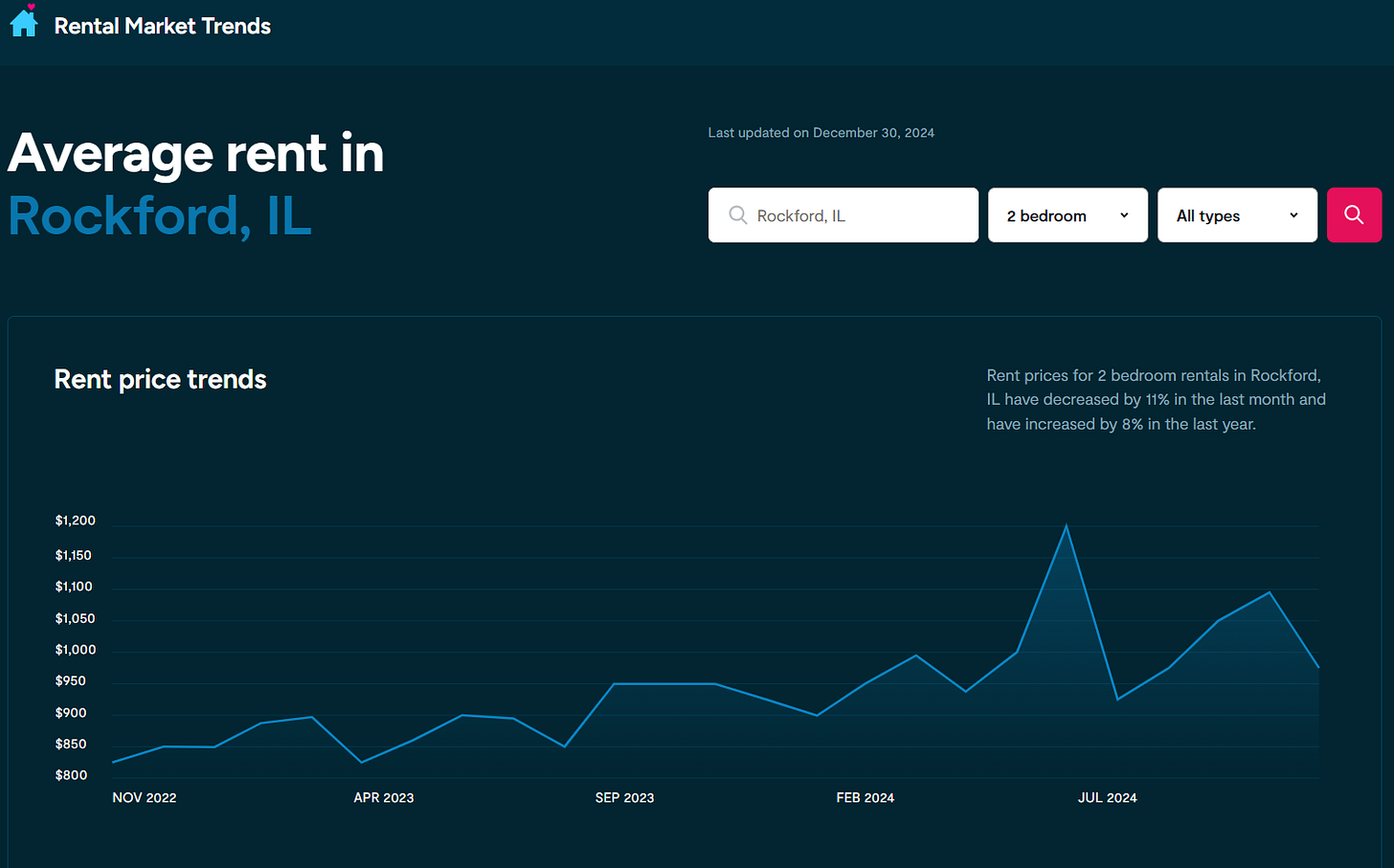
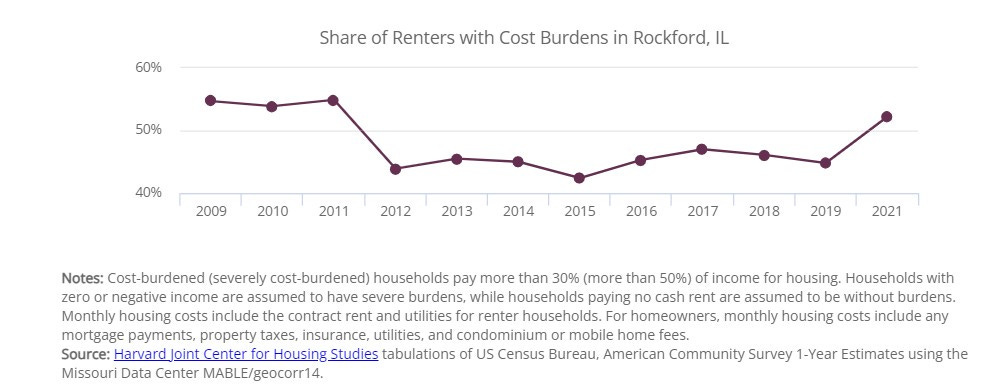
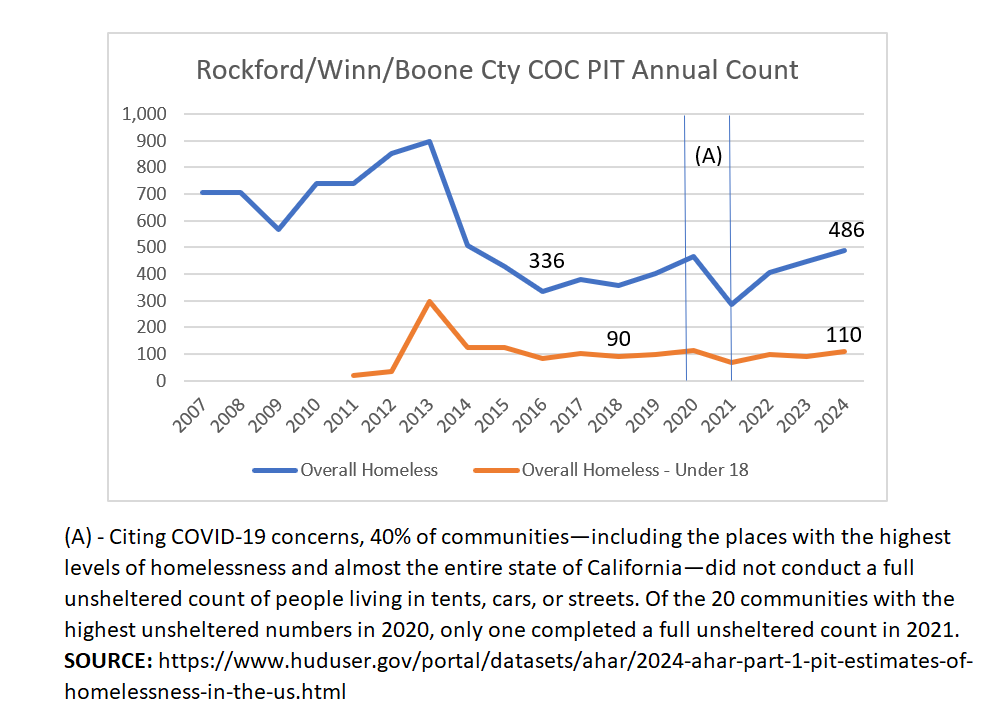
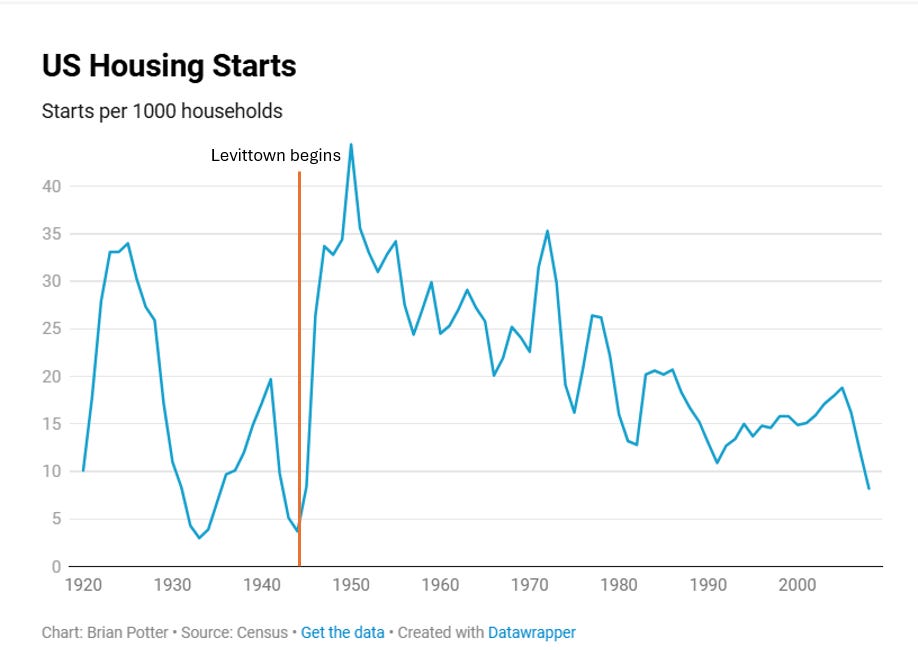
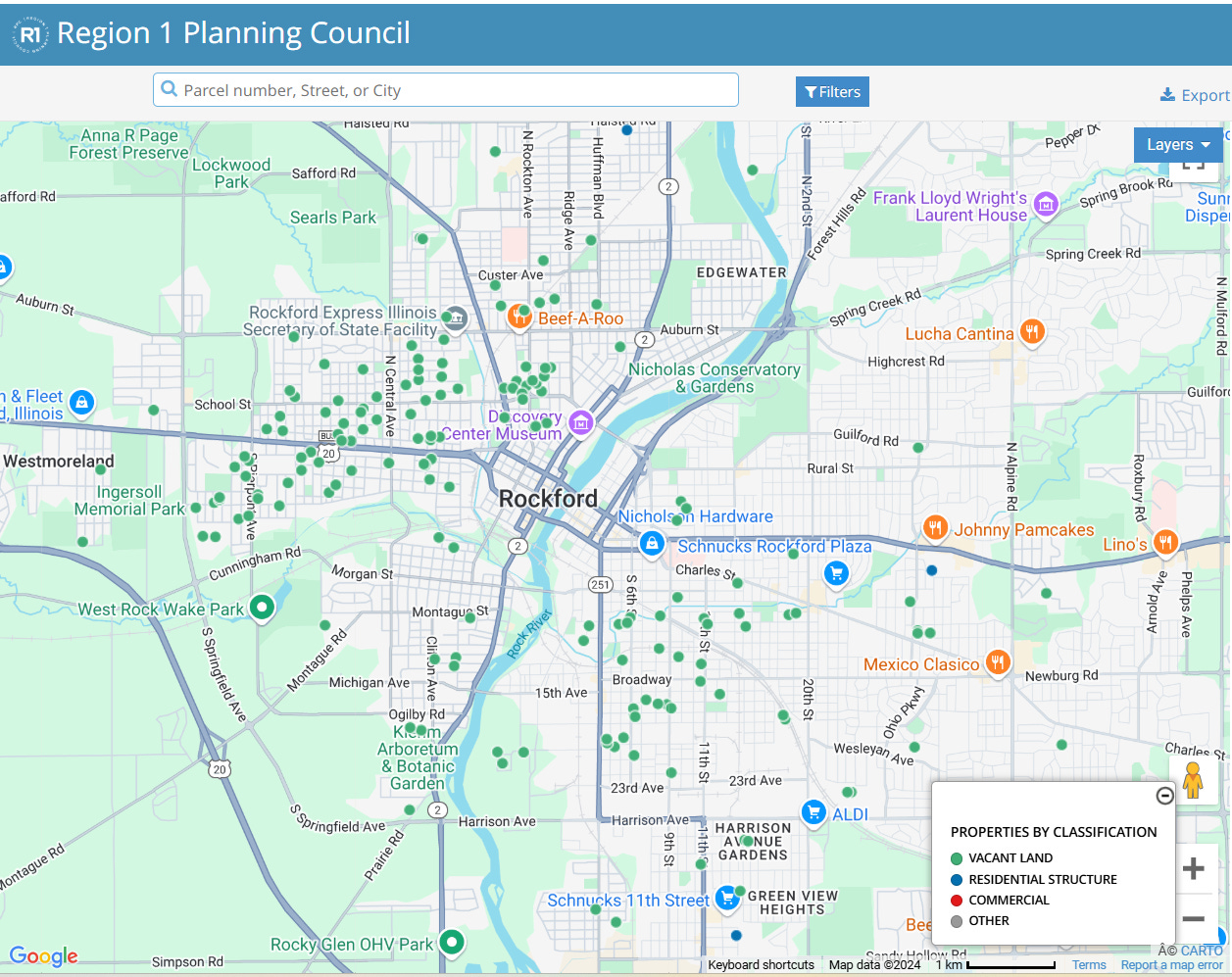
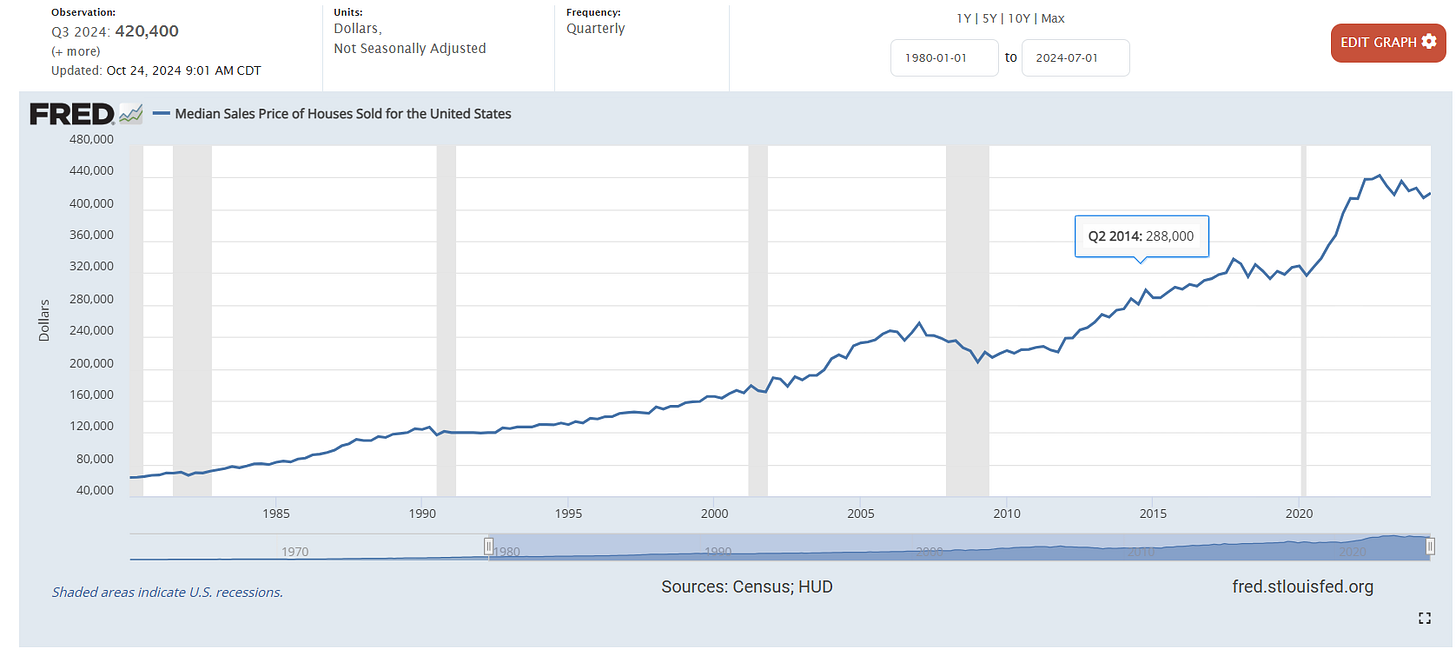
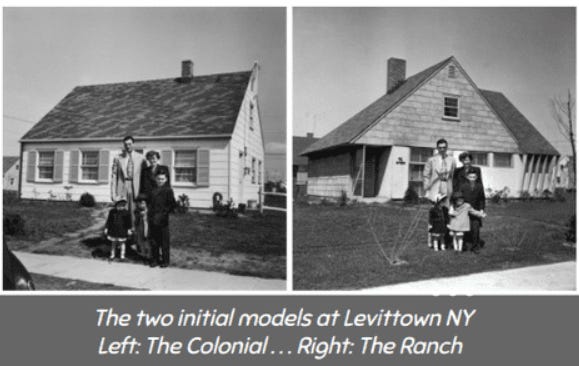
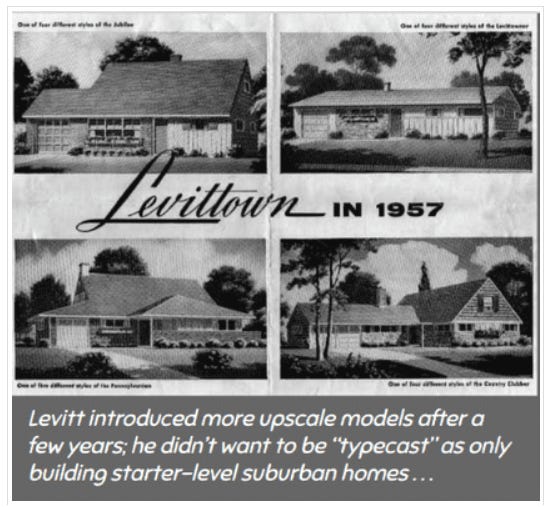
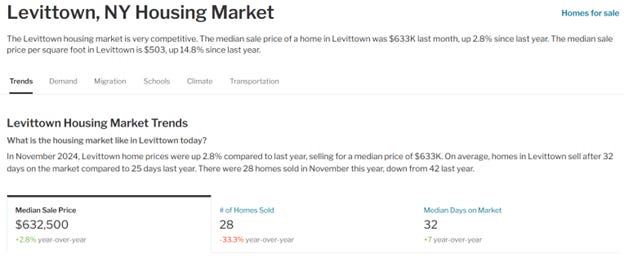
This is another excellent article that inspires supporters of housing/zoning reform. Your call for action is getting louder and is being heard by many.